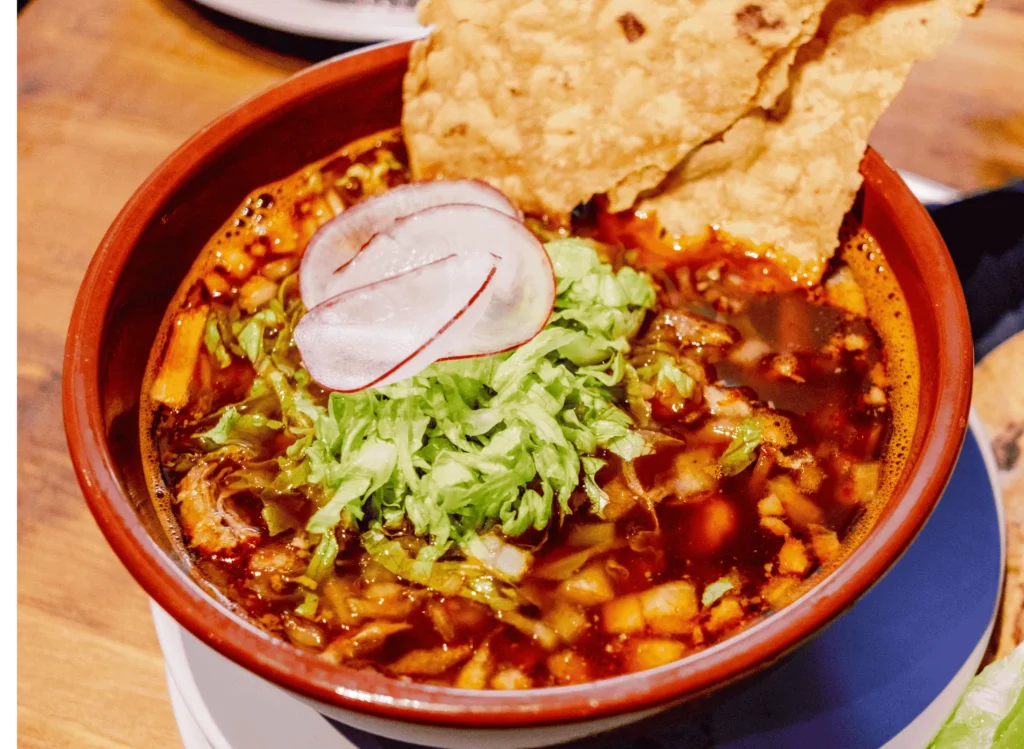Why Pozole is Mexico’s Most Beloved Communal Dish

Pozole is a traditional Mexican soup made with hominy, tender meat, and a chile-bright broth. Long, gentle simmering coaxes deep flavor, while a build-your-own topping bar turns every meal into a festive communal event.
Quick Pozole Facts:
- Main ingredient: nixtamalized corn (hominy)
- Three classic types: blanco (white), rojo (red), verde (green)
- Typical protein: pork shoulder; chicken is a popular alternative
- Serving style: generous bowls plus customizable toppings
- Origins: Pre-Hispanic Mesoamerica, 500+ years old
The Nahuatl word pozolli means “foam,” describing the way hominy kernels burst open during cooking. What started as an Aztec ceremonial dish has evolved into Mexico’s ultimate comfort food—equally welcome on weeknights or at holiday gatherings.
A single pot easily feeds 8–12 guests. While pozole simmers for 2–3 hours, most of that time is hands-off, giving you space to prep crunchy cabbage, radishes, onion, cilantro, lime wedges, and tortilla chips. When everyone assembles their perfect bowl, sharing turns into an interactive celebration of flavor and texture.
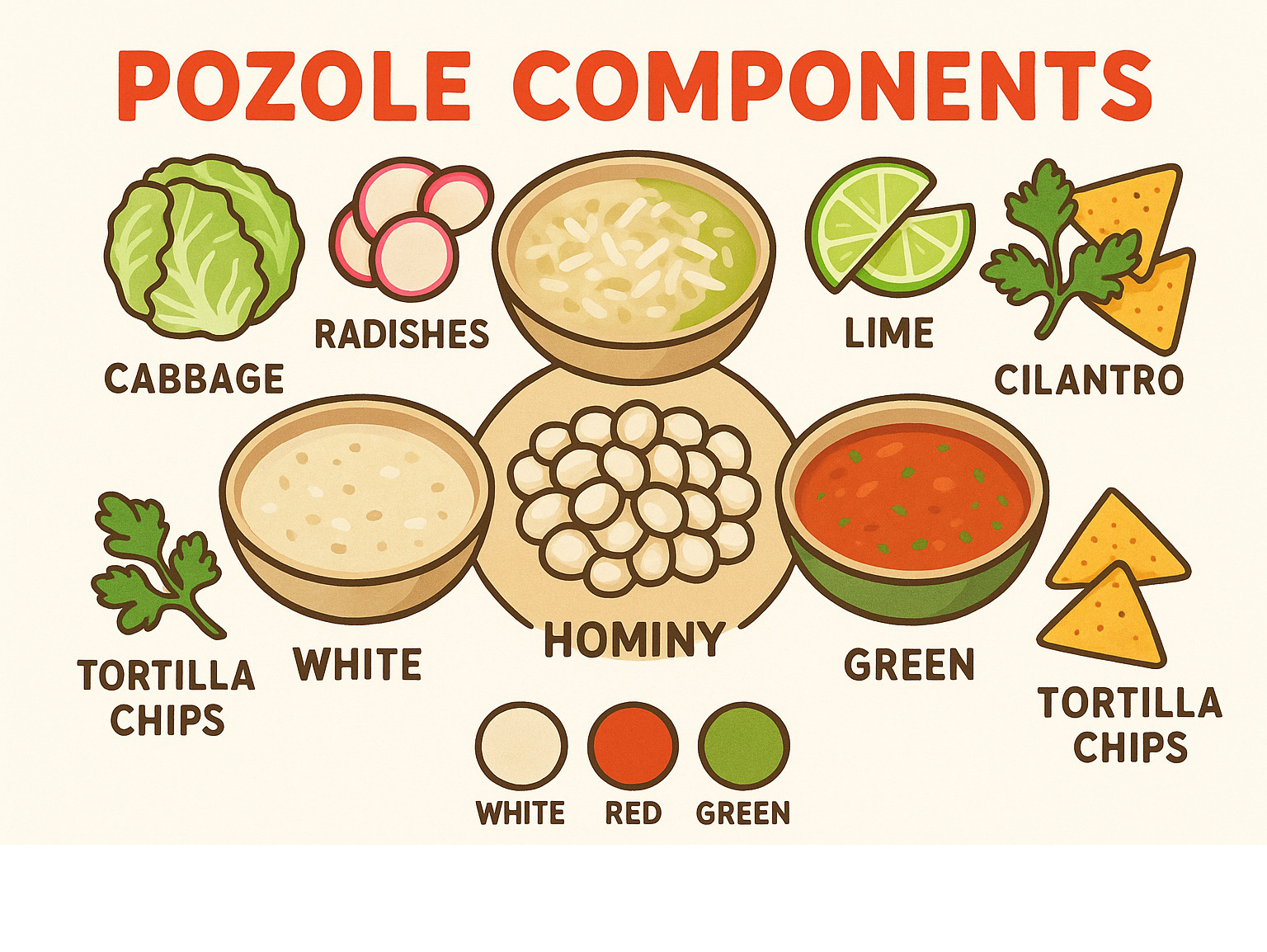
Basic pozole terms:
What Is Pozole? Ingredients & Hominy Magic
Think of pozole as Mexico’s answer to chicken soup – but with a lot more personality. This traditional Mexican stew combines hominy (specially treated corn), tender meat, and a rich, flavorful broth that’s been simmered low and slow until everything melds together perfectly.
What makes pozole special isn’t just one ingredient – it’s how they all work together. The hominy provides hearty substance, the pork shoulder or chicken adds protein and richness, and the chile-spiked broth brings everything to life with layers of flavor. A typical bowl delivers around 35-38g of protein and 9-16g of fiber, making it as nutritious as it is delicious.
The real magic happens during the long cooking process. Unlike a quick soup you throw together on a weeknight, pozole rewards patience. The slow-simmered broth develops complex flavors while tough cuts of meat become fork-tender and the hominy kernels burst open like little flowers.
The Significance of Hominy
Here’s where pozole gets fascinating from a food science perspective. Hominy isn’t just regular corn – it’s corn that’s been transformed through an ancient process called nixtamalization. This technique involves soaking dried corn kernels in an alkaline solution (traditionally lime water) to remove the tough outer hull.
This alkaline soak does something magical. It makes the corn’s nutrients more available to your body while creating that distinctive chewy-yet-tender texture that makes pozole so satisfying. When the treated kernels cook, they undergo what’s called a kernel “bloom” – they burst open and create the foam that gives pozole its name (pozolli means “foam” in Nahuatl).
The blooming effect isn’t just pretty to look at – it naturally thickens the broth and adds incredible texture & fiber to every spoonful. According to scientific research on hominy nutrition, this process significantly boosts the nutritional value compared to regular corn.
Most home cooks use canned hominy, which gives you all the benefits without the hours of prep time. Fresh hominy tastes amazing, but unless you’re planning a weekend project, the canned version works beautifully.
Core Pozole Ingredients
Traditional pozole starts with pork shoulder or Boston butt – those well-marbled, tough cuts that become incredibly tender during the long simmer. The fat renders out slowly, enriching the broth while the meat practically falls apart at the touch of a spoon.
Chicken serves as a popular alternative, especially in pozole verde. It creates a lighter, more delicate flavor that lets other ingredients shine. For vegetarian swaps, mushrooms or jackfruit provide that meaty texture and umami depth that makes pozole so satisfying.
The dried chiles are where regional preferences really show. Guajillo, ancho, and chipotle chiles create the deep red broth of pozole rojo, while fresh poblanos and tomatillos form the base of the green version. These aren’t just about heat – they contribute smoky, earthy, and sometimes fruity flavors that define each variation.
Aromatics like onion, garlic, cumin, and Mexican oregano build the flavor foundation. Bay leaves add subtle complexity, while proper seasoning brings everything together. The secret is layering these flavors thoughtfully rather than dumping everything in at once.
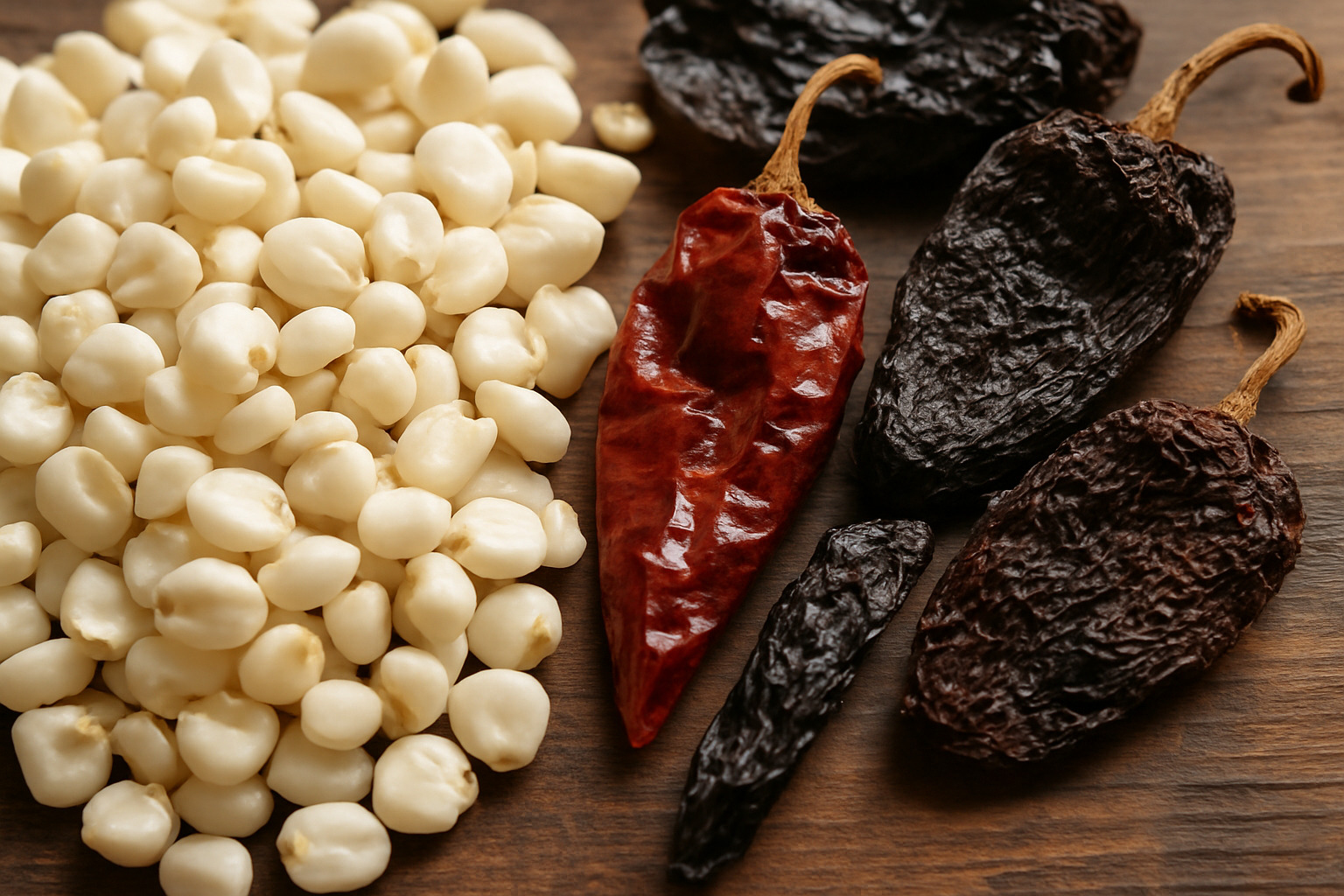
History & Cultural Significance of Pozole
Pozole carries more than 500 years of Mexican history in every spoonful. This isn’t just soup – it’s a bridge connecting ancient Mesoamerican traditions with modern Mexican celebrations. Understanding pozole’s remarkable journey from sacred ceremonial dish to beloved comfort food reveals why it holds such a special place in Mexican culture today.
The story begins long before Spanish conquistadors arrived in the New World. Indigenous peoples across Mesoamerica had already perfected the art of nixtamalization, the process that transforms ordinary corn into hominy. Archaeological evidence shows that corn-based stews remarkably similar to modern pozole were enjoyed throughout ancient Mexico, serving both as daily sustenance and ceremonial fare.
The name itself tells the story. Pozole comes from the Nahuatl word pozolli, meaning “foam” – a reference to how the corn kernels burst open like flowers when cooked. This ancient linguistic connection shows how deeply rooted the dish is in Mexico’s indigenous heritage, surviving conquest and colonization to remain essentially unchanged in its core preparation.
Pre-Hispanic Pozole Rituals
In ancient Mexico, pozole was far more than a meal – it was a sacred offering. The Aztecs prepared this ceremonial stew for special festivals honoring Xipe Totec, the god of agriculture and renewal. According to a brief history of pozole, pozole was considered so special that it graced the table of Emperor Moctezuma himself during religious ceremonies.
The communal aspect of pozole held deep spiritual meaning. Sharing the stew created bonds between participants and connected them to their gods. This tradition of communal feasting around steaming bowls continues today, though the spiritual significance has evolved into cultural celebration.
Historical accounts suggest that ceremonial pozole may have contained human flesh during the most sacred Aztec rituals, though scholars continue to debate both the extent and significance of this practice. What’s certain is that when Spanish colonizers arrived in the early 16th century, pork quickly replaced any questionable proteins, creating the foundation for the pozole we know today.
Pozole in Modern Celebrations
Today’s pozole serves as Mexico’s ultimate party dish. Walk into any Mexican home on New Year’s Eve, Independence Day, or Christmas, and you’ll likely find a massive pot of pozole simmering on the stove. The dish’s ability to feed crowds makes it perfect for quinceañeras, birthday parties, and family reunions where three generations gather around the same table.
Different regions have developed their own pozole traditions that reflect local tastes and customs. Some families designate specific days of the week for pozole – particularly Thursdays and Saturdays – while others reserve it strictly for special occasions. In Guerrero, red pozole dominates celebrations, while Jalisco favors the white version that lets diners customize their heat level.
The communal preparation adds to pozole’s celebratory nature. Family members often gather hours before guests arrive, sharing stories while chopping garnishes and tending the simmering pot. This collaborative cooking creates anticipation and strengthens family bonds before the actual meal begins.
Modern pozole has found new life in the digital age, with traditional recipes receiving thousands of enthusiastic comments and ratings online. This digital enthusiasm proves that pozole’s cultural significance continues to grow, connecting Mexican families across borders and introducing new generations to their culinary heritage.
Regional Variations of Pozole: Blanco, Rojo & Verde
Mexico’s pozole comes in three main varieties, each representing different regional traditions and flavor profiles. These aren’t just color variations – they’re distinct dishes that showcase the incredible diversity of Mexican cuisine. Pozole blanco (white), pozole rojo (red), and pozole verde (green) each tell their own story through ingredients, preparation methods, and cultural significance.
The beauty of these regional variations lies in how they reflect local ingredients and cooking traditions. States like Jalisco, Michoacán, Guerrero, Nayarit, Sinaloa, Zacatecas, and Morelos have all developed their own signature approaches to this beloved dish. Some regions are famous for their fiery red versions, while others pride themselves on bright, herbaceous green varieties.
What’s fascinating is how these variations often reflect the local climate and available ingredients. Regions with abundant tomatillo harvests naturally gravitated toward green pozole, while areas known for dried chile production perfected the red versions.
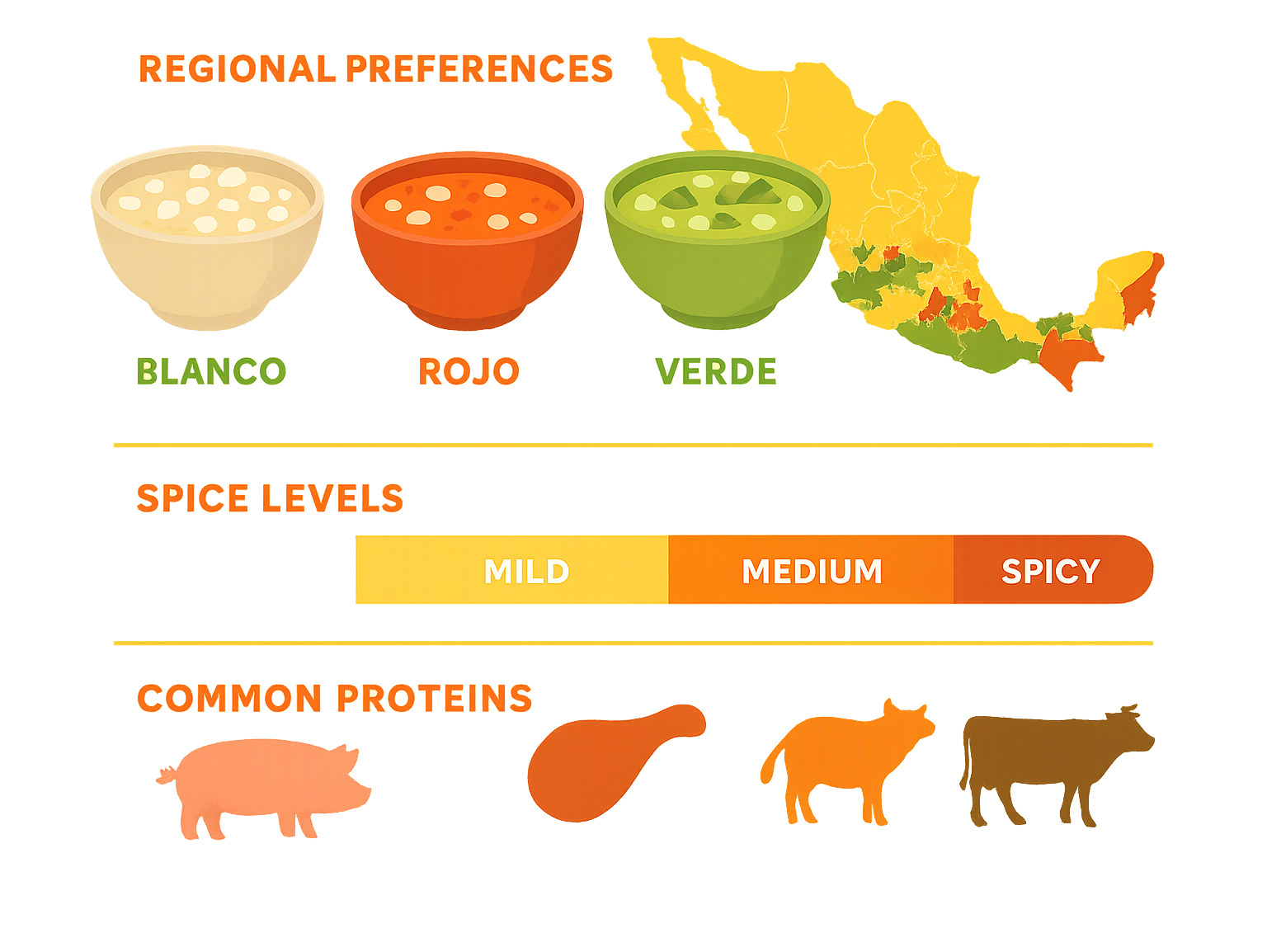
Pozole Rojo Flavor Profile
Pozole rojo gets its stunning deep red color from a carefully crafted blend of dried chiles. The stars of this show are typically guajillo, ancho, and chipotle chiles, each contributing its own personality to the final dish. Guajillos bring mild heat and fruity notes, anchos add earthy sweetness, and chipotles contribute that irresistible smoky depth.
The magic happens when these chiles are soaked in hot water until they become soft and pliable. They’re then blended into a silky smooth puree and strained to remove any stubborn skins or seeds. This creates a sauce that’s pure liquid flavor – complex, rich, and deeply satisfying.
Many experienced cooks swear by sautéing the chile puree before adding it to the pot. This extra step deepens the flavors and eliminates any raw edge, creating a more sophisticated broth. Some traditionalists even add a whisper of cocoa powder to improve the earthy notes, though the chiles themselves provide plenty of complexity.
The traditional protein for pozole rojo is pork shoulder, which becomes melt-in-your-mouth tender during the long simmer. The meat is often browned first, adding another layer of flavor that makes the final dish incredibly satisfying.
Pozole Verde Fresh Twist
Pozole verde offers a completely different experience – bright, fresh, and herbaceous. This version celebrates the vibrant flavors of tomatillos, poblano peppers, and fresh cilantro. The result is a bowl that tastes like summer in Mexico, even on the coldest winter day.
The green sauce typically starts with roasting tomatillos and poblanos to develop deeper flavors while maintaining that fresh, bright character. This roasting step adds subtle smokiness without overwhelming the delicate green flavors. Some regions include pepitas (pumpkin seeds) in their green sauce, which adds richness and helps thicken the broth naturally.
Heat comes from jalapeños or serranos, while cilantro provides that essential herbal brightness. Some cooks also add epazote, a pungent Mexican herb that pairs beautifully with the other green ingredients.
Pozole verde often features chicken instead of pork, though both proteins work wonderfully. The lighter meat complements the fresh, green flavors without competing for attention. Some regions prepare their green pozole with a combination of pork and chicken for added complexity.
Pozole Blanco Classic Base
Pozole blanco represents the dish in its purest form – a clear, golden broth that lets the hominy and meat shine without any chile coloring. Don’t mistake this simplicity for blandness, though. This version relies on masterful seasoning with salt, pepper, garlic, onion, and herbs to create incredible depth.
The beauty of pozole blanco lies in its versatility. It serves as the perfect canvas for customization, allowing diners to add their preferred level of heat through table salsas, chile powder, or hot sauce. This flexibility makes it particularly popular for family gatherings where spice tolerance varies dramatically.
Many smart cooks prepare pozole blanco as their base recipe, then customize individual portions with different chile sauces. This approach allows one pot to satisfy multiple preferences while maintaining the dish’s communal spirit. It’s like having three different pozole varieties from a single recipe.
Making Pozole at Home: Traditional vs Modern Shortcuts
Creating authentic pozole at home doesn’t have to be an all-day affair. While traditional methods involve soaking dried corn overnight and cooking it with cal (lime) for 12-24 hours to create hominy from scratch, modern shortcuts let you enjoy this beloved dish without the marathon prep time.
The beauty of pozole lies in its forgiving nature. Whether you choose the time-honored approach or accept convenient alternatives, the key is building layers of flavor through proper technique. Canned hominy provides consistent texture and saves hours of prep work, while an Instant Pot can transform tough pork shoulder into tender, shreddable meat in under an hour.
Step-by-Step Pozole Prep
Start with your protein – pork shoulder or chicken work beautifully. Season the meat generously with salt and pepper, then brown it in oil if you have time. This browning step isn’t absolutely necessary given pozole’s long cooking time, but it adds a deeper flavor that makes the extra few minutes worthwhile.
Build your broth by combining the meat with water or chicken stock, along with onion, garlic, bay leaves, and whole cumin seeds. Bring everything to a boil, then reduce the heat and let it simmer covered for 1-2 hours until the meat practically falls apart.
While the meat bubbles away, prepare your chile sauce if you’re making rojo or verde versions. Soak dried chiles in hot water for 30 minutes until they’re soft and pliable, then blend them with garlic and spices. Strain the mixture to remove any stubborn skins and seeds. For pozole verde, roast tomatillos and poblanos first, then blend with cilantro and jalapeños for that bright, fresh flavor.
Add your chile sauce and drained hominy to the pot, then continue simmering for another 30-60 minutes. The hominy should be tender but still have some bite, and the meat should shred easily with a fork. Taste and adjust seasoning – this is where you make it yours.
Adjusting Spice & Going Vegetarian
Heat control is everything with pozole. Remove seeds and membranes from dried chiles to keep the flavor while taming the fire. Start conservative – you can always add more heat, but you can’t take it back. For families with mixed spice tolerance, pozole blanco with chile sauce on the side keeps everyone happy.
Vegetarian pozole surprises people with how satisfying it can be. Mushrooms, jackfruit, or seitan replace traditional meat beautifully. Use vegetable broth as your base and add extra aromatics like smoked paprika or chipotle powder to compensate for the missing meat flavors.
Storage, Freezing & Reheating
Pozole is a meal prep champion. It stores in the refrigerator for up to one week, and honestly, it tastes even better after a day or two when all the flavors have had time to get acquainted. The hominy absorbs more of the broth’s flavor, and everything just comes together beautifully.
For longer storage, freeze portions for up to three months. Skip the toppings when freezing – those should always be fresh. The hominy and meat freeze well, though the texture might change slightly when thawed.
When reheating, add a splash of broth or water to restore the proper consistency. Pozole thickens as it sits, so thinning is usually necessary. Heat gently over medium-low heat, stirring occasionally to prevent sticking.
For our fellow food enthusiasts in New York City, pozole pairs beautifully with other Mexican favorites like Mexican Tortas and Birria Tacos for a complete Mexican feast.
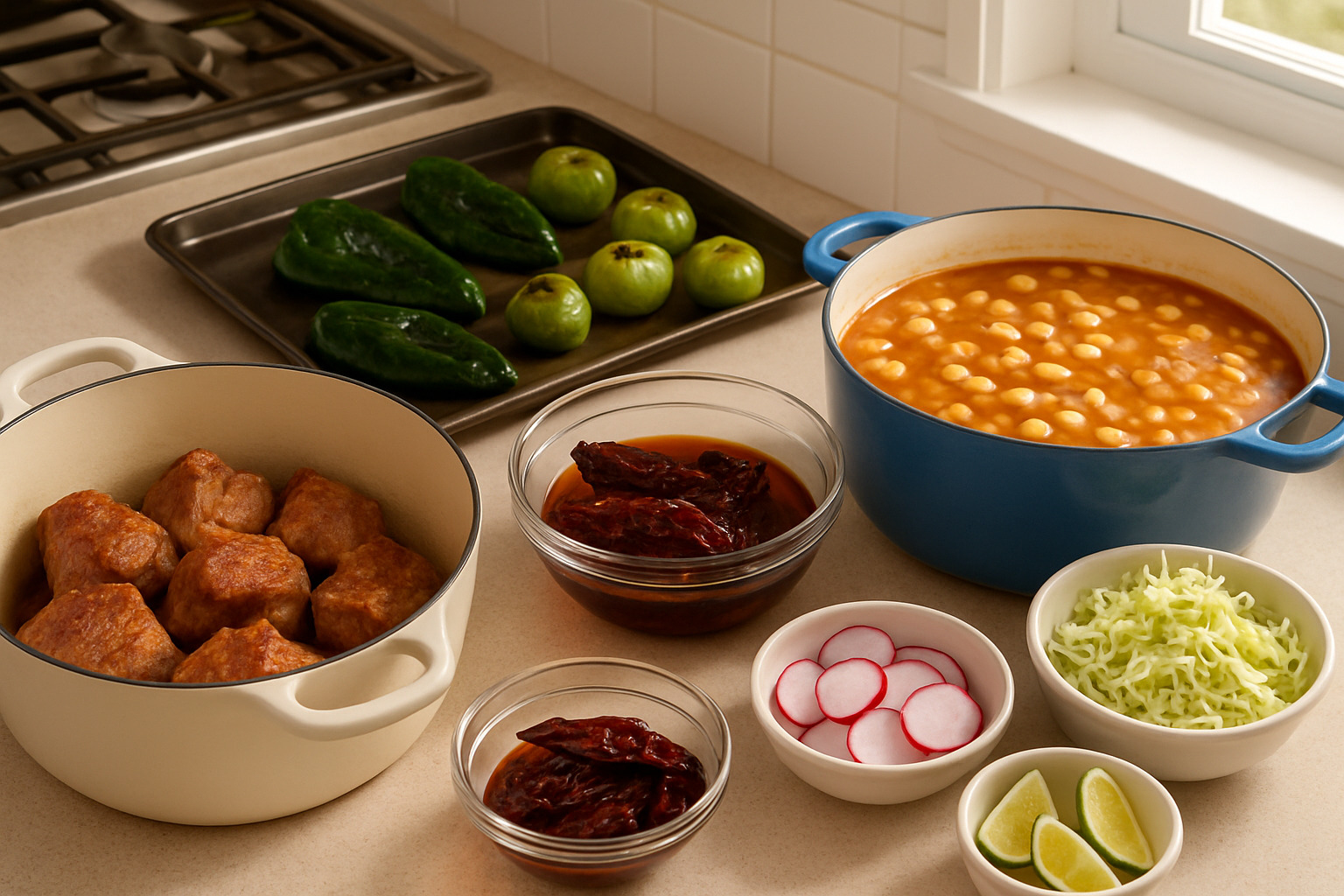
Serving Traditions & Perfect Pairings
The magic of pozole truly comes alive when you set up the traditional garnish bar. This isn’t just about adding toppings – it’s about creating an interactive dining experience that brings families and friends together around the table. Each person becomes their own chef, carefully selecting and arranging garnishes to create their perfect bowl.
The traditional serving setup includes shredded cabbage for satisfying crunch, paper-thin radish coins that add peppery bite, and diced white onion for sharp flavor contrast. Fresh cilantro leaves bring herbaceous brightness, while lime wedges provide that essential acidic pop that makes everything taste more vibrant.
Crispy tortilla chips or tostadas add textural interest and help stretch the meal further. Some families serve Chicharrones alongside for extra richness and crunch. The key is offering variety – something fresh, something crunchy, something sharp, and something to cool the heat.
Pozole Garnish Bar
Setting up your garnish bar is half the fun of serving pozole. Arrange small bowls around your dining table, each filled with a different topping. This creates a festive, restaurant-style presentation that gets everyone excited about the meal.
Start with the essentials: finely shredded green cabbage, sliced radishes, diced white onion, fresh cilantro, lime wedges, dried Mexican oregano, and crushed red pepper flakes. Add crispy tortilla chips or tostadas for texture, and don’t forget small spoons for each garnish bowl.
The ritual of building your bowl becomes part of the dining experience. Kids especially love customizing their pozole, often creating colorful, Instagram-worthy presentations. Some diners prefer minimal garnishes to taste the broth clearly, while others pile on everything available.
Sliced avocado makes a popular addition, though it’s not traditional in every region. Crumbled queso fresco adds creamy richness that pairs beautifully with the spicy broth.
Pozole & Street Food Culture
In Mexico, specialized restaurants called pozolerías serve nothing but pozole and related dishes. These establishments often operate on specific days – Thursday and Saturday are traditional pozole days in many regions. The communal nature makes it perfect for street food culture, where sharing meals builds community connections.
Street vendors serve pozole from massive pots, ladling the hot stew into disposable bowls topped with fresh garnishes. The portability and satisfying nature make it ideal for outdoor markets, festivals, and late-night dining when you need something hearty and warming.
Many pozolerías have been family-owned for generations, preserving recipes and techniques passed down through the years. These local spots offer the most authentic pozole experiences, often featuring regional variations you won’t find elsewhere.
For food enthusiasts seeking authentic experiences, finding local pozolerías provides insight into regional variations and traditional preparation methods. Those interested in exploring pozole’s place in Mexican street food culture might enjoy our Street Food Tours guide for tips on finding authentic culinary trips.
Beverage pairings traditionally include cold Mexican beer, fresh agua frescas, or warm Mexican hot chocolate for cooler weather. The rich, spicy broth pairs beautifully with crisp, refreshing drinks that cleanse the palate between bites.
Frequently Asked Questions about Pozole
What meats can I substitute in pozole?
Traditional pozole calls for pork shoulder, but don’t worry if you need alternatives – this adaptable dish welcomes many protein substitutions. Chicken ranks as the most popular swap, especially in pozole verde where its lighter flavor pairs beautifully with fresh herbs and tomatillos. Stick with bone-in chicken thighs rather than breasts for the richest flavor and most tender texture.
Beef creates a heartier version of pozole, though you’ll want to choose your cuts carefully. Chuck roast or short ribs work wonderfully, developing deep, rich flavors during the long simmer. Just keep in mind that beef can sometimes overpower the delicate corn notes that make pozole special.
Some adventurous cooks combine multiple meats – perhaps pork shoulder with chicken wings and a bit of beef – creating incredibly complex flavor profiles. This approach takes a bit more effort but delivers restaurant-quality results.
Vegetarian pozole has gained popularity and works surprisingly well. King oyster mushrooms or shiitake provide that meaty texture and umami depth you’re craving. Jackfruit mimics pulled pork remarkably well, while homemade seitan offers substantial protein and satisfying chewiness. Many plant-based cooks combine mushrooms with other meat alternatives for the most convincing results.
Can pozole be made ahead or frozen?
Here’s some great news: pozole actually improves with time. The flavors meld and deepen as the stew sits, making it perfect for meal prep. You can prepare pozole up to three days ahead and store it in the refrigerator in airtight containers.
The stew will thicken slightly as it cools – this is completely normal. Simply add a splash of broth or water when reheating to restore the perfect consistency. Heat gently on the stovetop, stirring occasionally to prevent sticking.
Pozole freezes beautifully for up to three months. Portion it into freezer-safe containers without any toppings for easiest reheating later. The hominy and meat freeze well, though you might notice slight texture changes after thawing. Always thaw overnight in the refrigerator before reheating.
Remember to save all those fresh toppings for serving time. The magic of pozole lies in the contrast between the hot, rich stew and the cold, crispy garnishes. No matter how you’ve stored your pozole, always add fresh cabbage, radishes, and lime just before eating.
How do I pronounce “pozole” correctly?
The correct pronunciation is “poh-SOH-leh” with emphasis on that middle syllable. Think of it as three distinct sounds: “poh” (like “po” in “poke”), “SOH” (stressed, like “so”), and “leh” (like “le” in “let”). The ‘z’ sounds like an ‘s’ in most Spanish dialects.
You might also see it spelled “posole,” particularly in the southwestern United States. This spelling reflects local linguistic traditions and is perfectly valid – both spellings refer to the same beloved dish.
The word traces back to the Nahuatl pozolli, meaning “foam.” This refers to how the hominy kernels burst open like little flowers during cooking, creating that characteristic foamy appearance. Understanding this etymology helps you appreciate both the pronunciation and the dish’s incredible 500-year history.
Don’t stress too much about perfect pronunciation – the important thing is enjoying this wonderful comfort food that brings people together around the table.
Conclusion & Next Steps
Pozole is so much more than a hearty soup – it’s a delicious time machine that connects us to centuries of Mexican tradition. Every spoonful carries stories of ancient Aztec ceremonies, Spanish colonial influence, and countless family gatherings where laughter mixed with the steam rising from communal bowls.
What makes pozole truly special isn’t just its rich, complex flavors or its impressive nutritional profile (35-38g of protein per serving!). It’s the way this dish brings people together. The slow simmer that fills your kitchen with incredible aromas. The colorful garnish bar that turns dinner into an interactive experience. The satisfied sighs as everyone customizes their perfect bowl.
We’ve journeyed through pozole’s three main personalities – the pure simplicity of pozole blanco, the smoky depth of pozole rojo, and the fresh brightness of pozole verde. Each variation tells a different regional story, yet all share that magical ability to transform simple ingredients into something that feeds both body and soul.
The beauty of pozole lies in its flexibility. Honor tradition with a slow-simmered pork shoulder and homemade chile sauce, or accept modern shortcuts with canned hominy and an Instant Pot. Either way, you’re participating in a culinary tradition that has adapted and thrived for over 500 years.
For those of us here in New York City who love exploring global flavors, pozole offers the perfect introduction to Mexican cuisine’s incredible depth. It’s accessible enough for beginners yet complex enough to satisfy serious food enthusiasts. Plus, with its ability to feed 8-12 people, it’s ideal for entertaining or meal prep.
At The Dining Destination, we believe that understanding dishes like pozole makes every culinary trip more meaningful. Whether you’re planning your next food-focused trip or simply want to expand your home cooking repertoire, these traditional recipes connect us to the cultures that created them.
Ready to explore more incredible food destinations? Our comprehensive Best Food Destinations guide will help you find authentic culinary experiences around the world. From busy street food markets to innovative restaurants, we’ll help you find the flavors that make each destination unforgettable.
The next time you gather loved ones around a steaming pot of pozole, you’re continuing a tradition that has brought communities together for centuries. That’s the real magic of this remarkable dish – it proves that the best meals are always the ones we share.

